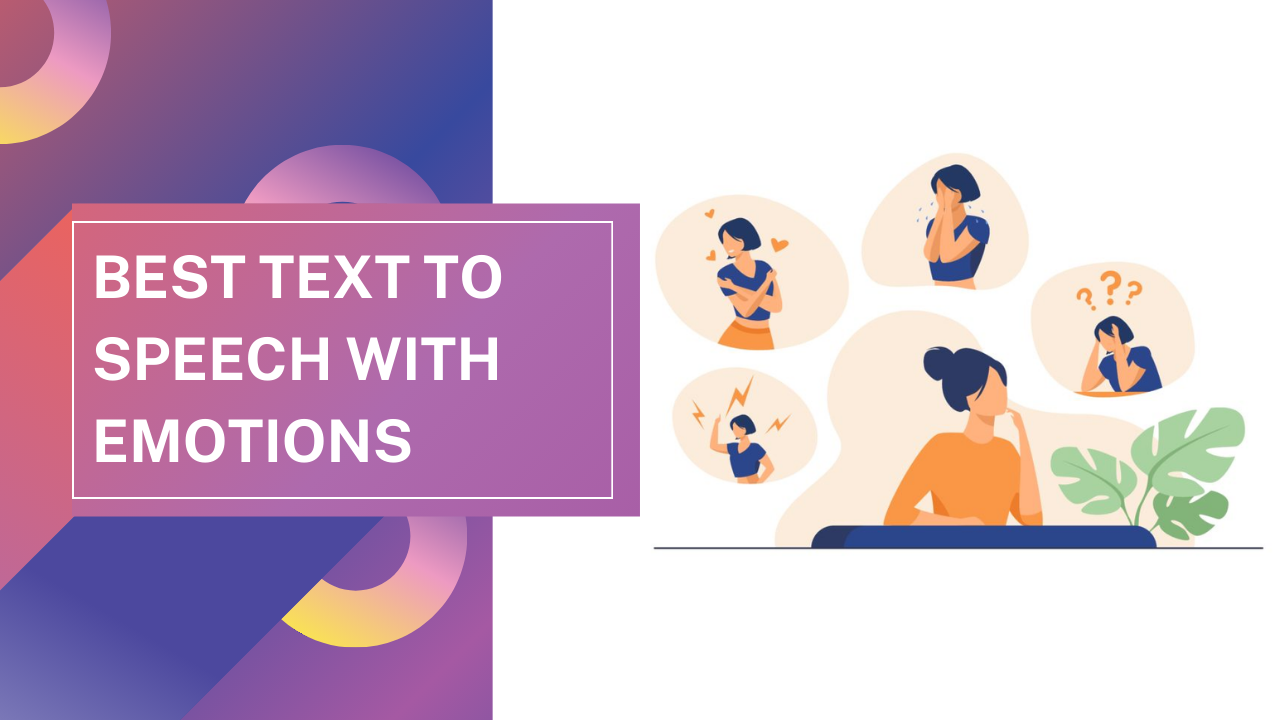Text-to-speech technology has come a long way, especially when it comes to expressing emotions. These tools can now read text aloud in a way that sounds more human and can convey different feelings like happiness, sadness, or excitement.
In this article, we will discuss the features, pros and cons, price, and best alternatives of the top five Text to Speech With Emotions. We’ll help you find the perfect tool that fits your needs, whether personal or not.
Why Text to Speech With Emotions?
Text to Speech (TTS) with emotions is important because it makes the speech sound more natural and easy to understand. When TTS systems can express emotions, they become more like human conversation.
This is helpful for everyone, especially for those who use technology to communicate, like people with speech difficulties. Adding emotions to TTS also makes learning or getting information more interesting.
It’s like listening to a person who sounds happy, sad, or excited. This can make stories or instructions more fun and easier to remember. It’s great for all ages, making technology more friendly and useful for everyone.
Top 5 Best Text to Speech With Emotions
1. TextoSpeech

TextoSpeech is a unique text-to-speech tool. It turns written words into spoken ones. What’s special is it adds feelings to the voice, like happiness or sadness.
This makes the speech sound more natural, not robotic. It helps make stories or messages feel real. People can choose different emotions to match their text.
Using TextoSpeech is easy and fun. You don’t need to be a tech expert. Anyone can use it to bring their words to life with emotions. It’s a great way to make listening more enjoyable.
Features of TextoSpeech
- Supports over 50 languages and 300 voices, providing a diverse range of content needs.
- Provides an easy-to-use text editor with real-time preview for fine-tuning voiceovers.
- Flexible pricing plans, including a free version, low-cost subscription options for advanced features, and a lifetime plan.
- Natural-sounding voices that are ideal for YouTube videos and multimedia projects.
- Web-based platform, ensuring accessibility and convenience without the need for software installation.
- Fast processing speeds allow for faster turnaround on voiceover projects, increasing productivity.
Pros and cons of TextoSpeech
Pros
- Variety of Voices and Languages
Ease of Use
Time-Saving
Cost-Effective
Consistency
Accessibility
Cons
- Limited Features in Free Version
Lack of offline functionality
2. Speechify

Speechify is a text to speech software that can read texts with emotions. This means it can make written words sound like they are spoken by a real person. It’s helpful for people who like to listen to books, articles, or any text.
The best part about Speechify is how it adds feelings to the speech. For example, it can read a happy story in an excited voice or a sad story in a softer tone. This makes listening more fun and real, like hearing a friend talk.
Using Speechify is easy. You just need to put in the text you want to hear. Then, the software reads it out loud for you. It’s a great tool for anyone who enjoys listening to stories or needs help reading.
Features
- Speechify offers over 30 languages and a wide range of 130+ voices, including natural-sounding and celebrity-like options.
- Includes reading speed control, highlighting text as it’s read, and converting text from books, PDFs, and web pages.
- Integrates with browsers and mobile devices, allowing seamless text-to-speech conversion across different platforms.
- Offers a free version with basic features and a premium plan with advanced capabilities like more voices and offline listening.
- High-quality voice synthesis, providing clear and natural-sounding audio for various content types.
- User-friendly interface, making it easy for users of all skill levels to navigate and use the tool effectively.
- Multi-device compatibility, supporting usage across computers, smartphones, and tablets for consistent accessibility.
Pros and cons
Pros
- Accessibility
- Language Learning
- Productivity
- OCR technology
- Support for Multiple Platforms
Cons
- Naturalness of Voice
- Accuracy and Pronunciation
- Subscription Costs
- Limited Context Understanding
3. Murf AI

Murf AI is a tool that makes text sound like real speech. It is very good because it can show emotions. This means when you use it, the voice can sound happy, sad, excited, or any other way.
This is useful for making videos or teaching lessons sound more interesting. The best part about Murf AI is that it is easy to use. You just type what you want to say, and it does the rest. It helps you pick the right voice and emotion.
This makes your projects sound better and more real. Everyone can use it, even if they are not good with technology. It’s like having a friend who helps you make your words come alive!
Features
- Murf AI offers over 120 voices across 20 different languages, catering to a global user base.
- Includes voice cloning, AI dubbing, and integration with Canva for enhanced voice-over capabilities.
- Advanced text-to-speech editor, voice modulation options, and real-time voice editing for precise control.
- Flexible pricing plans, including a free trial, basic, pro, and enterprise levels, to suit different user needs.
- High-quality, lifelike AI voices are ideal for professional and personal projects.
- User-friendly interface, making it accessible for beginners and experts alike.
- Extensive library of AI voices, including options for different ages, accents, and styles.
Pros and cons
Pros
- Wide variety of voices
- Extra Effects
- Google Slides Add-on
Performance - Scalability
Cons
- Cost
Learning Curve - Reliability
- Customization
4. Play HT

Play HT is a website that turns written words into speech. It’s special because it can make the speech sound like it has feelings. This is really helpful when you want the voice to sound happy, sad, or excited, just like a real person.
The way it works is easy. You type in what you want to say, and then you choose the kind of emotion you want. Play HT has lots of voices to pick from. This means your text will sound just the way you want it to, which is great for making things like videos or presentations.
This tool is perfect for anyone who needs to make their words sound real and alive. Whether you’re a teacher, a YouTuber, or just someone who likes to create, Play HT can make your words sound more interesting and true to life.
Features
- Murf AI offers over 120 voices across 20 different languages, catering to a global user base.
- Includes voice cloning, AI dubbing, and integration with Canva for enhanced voice-over capabilities.
- Advanced text-to-speech editor, voice modulation options, and real-time voice editing for precise control.
- Flexible pricing plans, including a free trial, basic, pro, and enterprise levels, to suit different user needs.
- High-quality, lifelike AI voices are ideal for professional and personal projects.
- User-friendly interface, making it accessible for beginners and experts alike.
- Extensive library of AI voices, including options for different ages, accents, and styles.
Pros and cons
Pros
- Wide variety of voices
- Extra Effects
- Google Slides Add-on
Performance - Scalability
Cons
- Cost
Learning Curve - Reliability
- Customization
5. Revoicer

Revoicer Revoicer is a special text-to-speech service that adds emotions to spoken words. This makes the speech sound more natural, like a real person talking. It’s not just reading the words, it’s like someone is feeling them.
This is great for making stories or messages more lively and real. This service is really helpful for anyone who wants to make their written words sound like they’re being spoken with real feelings. It’s easy to use too.
You just put in your text, choose the emotion you want, and Revoicer does the rest. It’s perfect for making your messages stand out and feel more personal.
Pros And Cons of Revoicer
Pros
- Accessibility
- Convenience
- Variety of Uses
- Time-Saving
Cons
- Unrealistic Voices
- Language Limitations
- Bad Context Understanding
FAQs
What is Text to Speech with Emotions?
Text to Speech with Emotions (TTS-Emotions) is an advanced form of text-to-speech technology that not only converts written text into spoken words but also incorporates emotional tones and inflections.
How does Text to Speech with Emotions Work?
TTS-Emotions works by analyzing the text for emotional cues and context. Advanced algorithms and artificial intelligence process the text and determine the appropriate emotional tone. The speech synthesis engine then modulates the voice output to match these emotions, adjusting factors like pitch, speed, and intonation.
Can TTS-Emotions detect all types of emotions?
While TTS-Emotions technology is constantly improving, it may not perfectly detect or express all types of emotions. Common emotions like happiness, sadness, anger, and excitement are generally well-represented, but more nuanced or complex emotions might be less accurately conveyed.
Are there limitations to TTS-Emotions technology?
Yes, there are limitations. The accuracy of emotion detection can vary based on the complexity of the text and the subtlety of emotional expressions. Additionally, the synthesized speech, while advanced, might still lack the full range of human emotional expression.
Conclusion
Text-to-speech technology has made significant strides, especially in conveying emotions. This enhances user experience, making interactions more natural and engaging.
TextoSpeech stands out in this field. Its ability to infuse speech with a range of emotions brings a human touch to automated voices. This innovation opens new possibilities in digital communication, making it more accessible and relatable to everyone.

